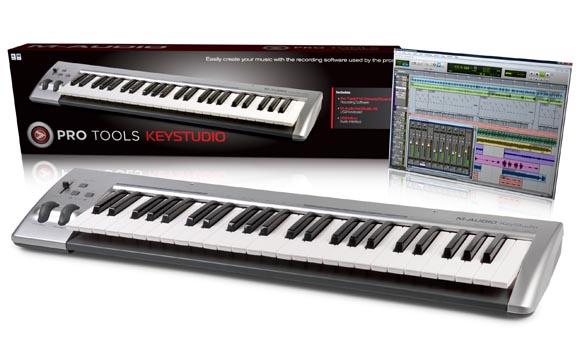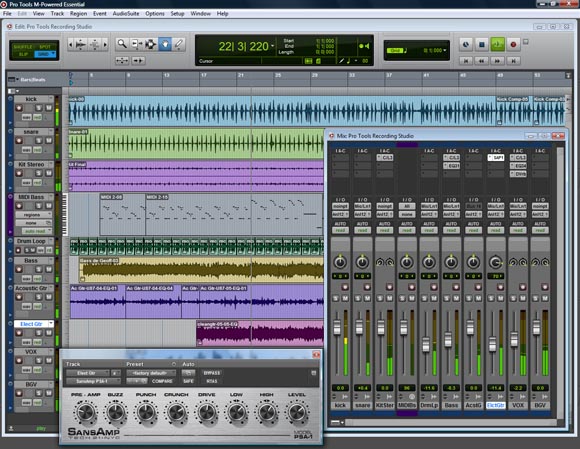
A young, aspiring musician walks into a consumer electronics store. (Let’s call it Big Buy, and imagine people wearing… red polo shirts.) They wander into the game aisle and muse at the latest music games in the video game section – $60-100 in price. But there’s an endcap with something else: a box of Pro Tools that’ll run on their computer, plus a ready-to-use audio interface, for $99-129. Instead of Guitar Hero, they leave with Pro Tools – a name they already knew.
See full details of the new lineup, with photos.
This idea is nothing new – for many years, it’s been possible to do great stuff with $100 on a computer. But the most powerful brand in music production (Pro Tools) has remained notably absent. Instead, that hypothetical consumer would find a smattering of consumer-only choices with names they likely wouldn’t recognize. Meanwhile, the name “Pro Tools,” and the software interface that made it popular, have been limited to more complex offerings sold through specialists.
Today changes all of that. Gone is the idea that “Pro Tools” is only for the high end. Gone is the iLok hardware dongle. (You still need either the Micro or Fast Track interface plugged in, but the target market for this product may not care.)
There are three offerings:
A vocal studio, bundled with a USB mic (similar to M-Audio’s Luna).
A “recording” studio, bundled with a simple USB bus-powered audio interface (the previously-available Fast Track.
The “KeyStudio”, bundled with a 49-key USB keyboard. The software comes with 60+ virtual instruments, says Avid, so you’ve got quite a lot to play.
The software included in each has some limitations – it has 32 tracks (16 audio, 8 instrument, and 8 MIDI), and more basic routing options (3 inserts per track, 2 audio inputs, and 2 outputs). The absence of multitrack recording is probably the biggest restriction. But you nonetheless get a range of virtual instrument sounds and effects, plus a full complement of editing and mixing features.
On the same day that people are rediscovering The Beatles through a video game, and video games are causing people to rediscover music making, you can buy a studio for about the same price.
Now, if you’re reading this site, that’s probably not news. But it could be news to quite a lot of people who haven’t discovered computer music making. And it represents a tectonic shift in how the titan of music making software treats its flagship.
What’s hard to overstate is how profoundly Avid has changed overnight some of the rules they themselves wrote. There’s no diplomatic way to put this: for years, Avid/Digidesign has been a dinosaur, with all the negatives and positives that can come from that. They have all the heft of a dinosaur, the footprint – and all of the kind of ongoing assumptions about how to do business. The whole modus operandi of Pro Tools seems to have been protecting the crown jewels. The idea of something called Pro Tools sold to a genuine mass market at this price, without any differentiation between “consumer” and “pro” or “mass-market” and “musician” is largely new. And that could point to a sea change for the whole industry further in the future.

In fact, even Avid’s competition has followed the unspoken rule that your flagship product and the crippled version you sell to the mass market have to be kept isolated. Apple is careful to distinguish Garage Band from Logic, iMovie from Final Cut. Ableton’s entry-level versions of Live have key features removed – even the LE version that costs about twice what Pro Tools Essentials, with hardware, does. Cakewalk doesn’t call its entry-level software SONAR. MOTU doesn’t have an entry-level Digital Performer. Steinberg has Nuendo, Cubase… and, remember, most people who have never heard of any of these things have heard of Pro Tools. The result is the industry takes a bunch of names that aren’t well-known to the general public, and then …adds more.
The kind of gymnastics manufacturers do to keep the low-end from being the “real” product sometimes border on absurdist.
For instance, take M-Audio’s Fast Track, the interface now included with Pro Tools Essentials Studio. It’s a simple box with a USB jack and some audio inputs. But a first-time consumer probably wants to plug it into a computer – including a Windows PC that lacks a pre-installed GarageBand – and have something happen.
The Fast Track is marketed as coming from “M-AUDIO,” a company most people outside our bubble have never heard. It’s “compatible” with Pro Tools “M-Powered” (not an actual word). Oh, except that’s a separate purchase – and it comes with a special plastic USB dongle that you have to plug into your computer called the iLok. The average consumer hasn’t ever seen hardware copy protection.
On the Fast Track product page, the fine print about how the other software bundles work is longer than the description of the actual product.
*M-Audio Session software is available in Fast Track USB packages sold at consumer electronics retailers, and currently works only with Fast Track USB and M-Audio Micro hardware. If you purchased a Fast Track USB package from your local pro audio dealer, you received a professional software bundle including Ableton Live Lite. If you wish to purchase Session for use with your Fast Track USB, it is available directly from M-Audio for only $25 (valued at $69.95). Purchase Session now.”
What’s Session? That’s another software product, unrelated to Pro Tools.
Hell, I’m confused, and I do this for a living.
Now, instead of that complexity, you can get one box that includes both the Fast Track and Pro Tools Essentials, without any of the fine print. (As pictured.) If those stores had decent commissions, I’d just park myself in one around the holiday season.

Don’t get me wrong: Pro Tools Essentials has tough competition. GarageBand has been down this path before, minus the hardware and the “Pro Tools” name, but with the very serious “Apple” name attached. The aforementioned Rock Band franchise will now have its game songs produced in Reaper, a $60 piece of software that does for some of its advanced users what Pro Tools might. The hardware tie-ins here, ironically, may be less valuable to people than the software – Pro Tools, more than a keyboard or mic, is likely to sell the packages.
The bottom line, though, is that a box that says “Pro Tools” at $99 is important to the whole industry. And if Avid is redefining what a “Pro” tool is, something bigger than even Avid really is shifting. The technological shift is hardly new, but the ability to recognize that in the market has been a long time coming.
I’m curious to see what will happen next.